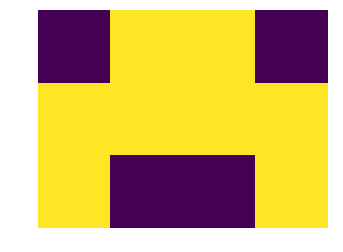run-length 编码和解码
Contact me
- Blog -> https://cugtyt.github.io/blog/index
- Email -> cugtyt@qq.com
- GitHub -> Cugtyt@GitHub
本文的代码来自于Run-Length Encode and Decode paulorzp。
这个run-length是一个数值只取0和1的二维矩阵,一般的用途是描述图像的mask,比如:

看一下简单的内容和图像的对应:

这里先贴出编码和解码的代码,代码来源:
def rle_encode(img):
'''
img: numpy array, 1 - mask, 0 - background
Returns run length as string formated
'''
pixels = img.flatten()
pixels = np.concatenate([[0], pixels, [0]])
runs = np.where(pixels[1:] != pixels[:-1])[0] + 1
runs[1::2] -= runs[::2]
return ' '.join(str(x) for x in runs)
def rle_decode(mask_rle, shape):
'''
mask_rle: run-length as string formated (start length)
shape: (height,width) of array to return
Returns numpy array, 1 - mask, 0 - background
'''
s = mask_rle.split()
starts, lengths = [np.asarray(x, dtype=int) for x in (s[0:][::2], s[1:][::2])]
starts -= 1
ends = starts + lengths
img = np.zeros(shape[0]*shape[1], dtype=np.uint8)
for lo, hi in zip(starts, ends):
img[lo:hi] = 1
return img.reshape(shape)
我们用上面的简单例子来一步步分析编码和解码的过程:
编码
- 定义mask:
mask = np.array([
[0, 1, 1, 0],
[1, 1, 1, 1],
[1, 0, 0, 1]
])
mask的图像就是上方那个简单的图像。
- 扁平化 ``` python mask.flatten()
array([0, 1, 1, 0, 1, 1, 1, 1, 1, 0, 0, 1]) ```
- 首尾加0
np.concatenate([[0], mask, [0]])
> array([0, 0, 1, 1, 0, 1, 1, 1, 1, 1, 0, 0, 1, 0])
- 每个元素与前一个元素比较,找到不同的位置
runs = np.where(mask[1:] != mask[:-1])[0] + 1
> array([ 2, 4, 5, 10, 12, 13])

- 作差,找到所有连续1的起始位置和个数
runs[1::2] -= runs[::2]
> array([ 2, 2, 5, 5, 12, 1])
至此,编码就完成了。
code = ' '.join(str(x) for x in runs)
注意到它这里的起始位置是从1开始算的
解码
- 从字符串中分割code成list
code = code.split()
> ['2', '2', '5', '5', '12', '1']
- 解出起始位置和个数
starts, lengths = [np.asarray(x, dtype=int) for x in (code[0:][::2], code[1:][::2])]
> (array([ 2, 5, 12]), array([2, 5, 1]))
- 因为python本身是从0开始计算的,所以减1取真实的起始位置和终点位置
starts -= 1
ends = starts + lengths
starts, ends
> (array([ 1, 4, 11]), array([ 3, 9, 12]))
- 最后一步,恢复元数据
decode_mask = np.zeros(3*4, dtype=np.uint8)
for lo, hi in zip(starts, ends):
decode_mask[lo:hi] = 1
> array([0, 1, 1, 0, 1, 1, 1, 1, 1, 0, 0, 1], dtype=uint8)
结果图:

总结起来就是记录所有连续1的起始位置和长度作为编码,解码依据这个记录恢复就好。